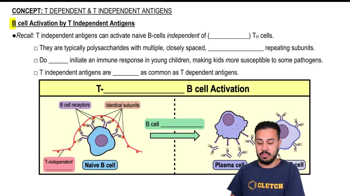T Dependent & T Independent Antigens definitions Flashcards
 Back
BackT Dependent & T Independent Antigens definitions
1/15
Terms in this set (15)
- B cell activationThe process by which B cells become activated to respond to antigens, involving either T dependent or T independent pathways.
- T dependent antigensAntigens that require helper T cells for B cell activation, involving a multi-step process including antigen presentation on MHC class II.
- T independent antigensAntigens capable of activating B cells without helper T cells, often long polysaccharides with repeating subunits.
- Helper T cellsImmune cells that assist in the activation of B cells by recognizing antigens presented on MHC class II molecules.
- Naive B cellsInactive B cells that have not yet encountered an antigen and require activation to respond to pathogens.
- B cell receptors (BCRs)Molecules on B cell surfaces that bind to specific antigens, initiating the activation process.
- MHC class II moleculesProteins on B cell surfaces that present processed antigen fragments to helper T cells for recognition.
- CytokinesSignaling molecules released by helper T cells to activate B cells during immune responses.
- Plasma cellsDifferentiated B cells that secrete antibodies to neutralize pathogens.
- Memory B cellsB cells that remain after an infection to provide a faster response upon re-exposure to the same antigen.
- PolysaccharidesLong carbohydrate molecules with repeating subunits, often forming T independent antigens.
- Immune responseThe body's defense mechanism against pathogens, involving B cell activation and antibody production.
- PathogensMicroorganisms that cause disease, targeted by the immune system through B cell activation.
- AntibodiesProteins produced by plasma cells that bind to antigens to neutralize or mark them for destruction.
- T cell receptors (TCRs)Molecules on T cells that recognize antigens presented by MHC class II molecules on B cells.



